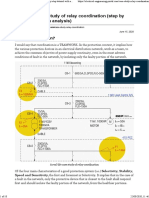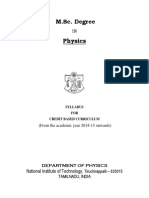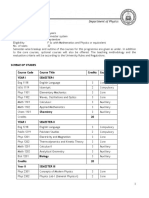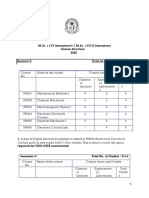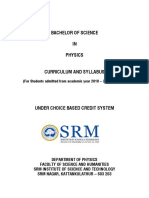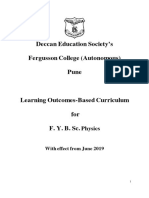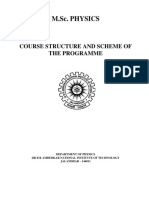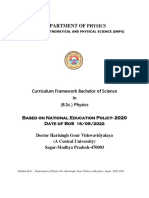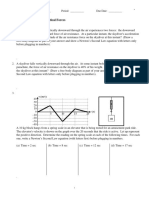Syllabus
Uploaded by
classikSyllabus
Uploaded by
classikDEPARTMENT OF PHYSICS
BACHELOR OF SCIENCE IN PHYSICS
HISTORY
The Department of Physics, College of Natural Sciences, is one of the foundation
Departments of the University established in 1988. Recent changes in nomenclature
and academic programmes led to a change in the former name (i.e. Department of
Physical Sciences) to its present name.
By and large, the Department has contributed significantly to the development of the
University and is still striving to ensure that the aims for which the University is
established are achieved.
The Department of Physics offers a single honours degree programme in Physics as
well as Postgraduate programmes leading to the award of Master of Science and
Doctor of Philosophy in various areas of specializations in Physics. Some graduates of
the Department are presently on the staff list of the Department as academic staff.
PHILOSOPHY AND OBJECTIVES
The goal of the B.Sc. degree programme in Physics is to produce skilled manpower that
is adequately furnished with the comprehensive information required for engaging in
meaningful research and industrial applications.
The objectives of the B.Sc. degree programme in Physics are:
l To provide students with a broad and balanced foundation of Physics
knowledge and practical skills.
l To instill in students a sense of enthusiasm for Physics, an appreciation of its
applications in different contexts.
l To involve the students in intellectually stimulating and satisfying experience
of learning and studying.
l To develop in students the ability to apply their knowledge and skills in Physics
to theoretical and practical problems.
l To develop in students, through an education in Physics a range of
transferable skills of values in Physics and other areas.
l To provide students with a knowledge and skill base for further studies in
Physics or multi-disciplinary areas involving Physics.
UNIVERSITY CALENDAR 2019-2022 647
3 YEAR 4 YEAR
PROGRAMME PROGRAMME
(A)University Compulsory Courses
(i) General Studies (GNS) 5 9
(ii) Relevant Compulsory Course 3 3
(ETS 206 and PHS 364)
(iii) 100Level Courses - -
(B) Core Courses -
(i) 100 Level - 41
(ii) 200 Level 38 38
(iii) 300 Level 16 16
(iv) 400 Level 39 39
(v) IndustrialTraining 16 16
(C) All Electives 21 21
Total 138 183
Academic Staff
Name Qualification Specialization Designation
B. S. Badmus B.Sc., M.Sc. (Ibadan), Applied Geophysics Professor and
Ph.D. (Lagos) HOD
A. O. Mustapha B. Sc., M. Sc. (Zaria), Radiation & Health Professor
Ph.D. (Nairobi) Physics
O. D. Akinyemi B.Sc., M.Sc., Ph.D. (Ibadan) Solid Earth Physics Professor
G. A. Adebayo B.Sc. (Abeokuta), M.Sc., Theoretical Condensed Professor
Ph.D.(Ibadan) Matter Physics
V. F. Makinde B.Sc., M.Sc.(Ilorin), Ph.D(Zaria) Applied Geophysics Professor
Itunu C. B.Sc., M.Sc., Ph.D. (Ibadan) Radiation & Health Reader
Okeyode Physics
Olufunmilayo O. B.Sc., M.Sc., M.Phil. (Ibadan), Radiation & Health Senior Lecturer
Alatise Ph.D. (Abeokuta) Physics
F. G. Akinboro B.Sc. (Madras), PGD (Madras), Environmental (Solar Senior Lecturer
M.Sc. (Lagos), Ph.D. (Abeokuta) Physics)
J. O. Akinlami B.Sc., M.Sc., Ph. D. (Ibadan) Theoretical Condensed Senior Lecturer
Matter Physics
G. O. Layade B.Sc., M.Sc. Ph.D. (Ibadan) Geophysics Senior Lecturer
A. A. Alabi B.Sc., M.Sc. (Ibadan), Geophysics Senior Lecturer
Ph.D. (Abeokuta)
O. T. Olurin B.Sc., M.Sc. Ph.D. (Abeokuta) Geophysics Lecturer I
S. A. Ganiyu B.Sc., M.Sc. Ph.D. (Abeokuta) Geophysics Lecturer I
O. P. Adebambo B.Sc., M.Sc. Ph.D. (Abeokuta) Theoretical Condensed Lecturer II
Matter Physics
UNIVERSITY CALENDAR 2019-2022 648
100 Level: First Semester
Course Code Course Title U L T P
PHS 101 General Physics I 3 2 1 -
PHS 191 Physics Laboratory I 1 - - 1
MTS 101 Algebra 3 2 1
MTS 103 Vectors & Geometry 2 2 -
BIO 101 General Biology I 2 2 -
BIO 103 Intro. to Physiology 2 2 - -
BIO 191 Practical Biology 1 - - 1
CHM 101 Physical Chemistry I 3 3 -
CHM 191 Practical Chemistry I 1 - - 1
GNS 101 Use of English 2 2 -
GNS 111 Introduction to social problems 1 1 -
CSC 101 Introduction to Computer Science 3 2 - 1
Total 24 18 2 4
100 Level: Second Semester
Course Code Course Title U L T P
PHS 102 General Physics II 3 2 1 -
PHS 192 Physics Laboratory II 1 - - 1
MTS 102 Calculus and Trigonometry 3 2 1 -
MTS 104 Mechanics 3 2 1 -
BIO 102 General Biology II 2 2 - -
BIO 192 Practical Biology II 1 - - -
CHM 102 Intro. Organic Chemistry 2 2 - 1
CHM 104 Intro. Inorganic Chemistry 2 2 - -
CHM 192 Practical Chemistry II 1 - - 1
GNS 102 Intro. To Nigerian History 1 1 - -
CSC 102 Introduction to Computer Algorithm Techniques 2 2 - -
Total 21 15 3 3
200 Level: First Semester
Course Code Course Title U L T P
PHS 211 Classical Physics I 2 2 - -
PHS 231 Waves and Optics 3 2 1 -
PHS 233 Introduction to Space Physics 2 2 - -
PHS 251 Introductory Modern Physics 3 2 1 -
PHS 291 Experimental Physics I 1 - - 1
CSC 203 Computer Programming I 3 2 - 1
MTS 241 Mathematical Method I 3 2 1 -
STS 201 Statistics for Agricultural and Biological Sciences 3 2 1 -
AGE 321 Workshop Practice 2 1 - 1
Total 25 17 5 3-
UNIVERSITY CALENDAR 2019-2022 649
200 Level: Second Semester
Course Code Course Title U L T P
PHS 222 Thermal Physics 3 2 1 -
PHS 242 Electronics I 3 2 1 -
PHS 292 Experimental Physics II 1 - - 1
CSC 204 Computer Programming II 3 2 - 1
MTS 232 Ordinary Differential Equation 3 2 1 -
GNS 201 Writing & Literary Appreciation 1 1 - -
GNS 203 Use of Library 1 1 - -
GNS 202 Elements of Politics and Government I 1 1 - -
GNS 204 Logic and History of Science 2 2 - -
ETS 206 Entrepreneurial Studies I 2 2 - -
PHS 362 Introductory Materials Science 3 2 1 -
PHS 364 Energy and environment 1 1 - -
Elective 3 2 1 -
Total 27 20 5 2
ELECTIVE COURSES
MTS 214 Complex Analysis I 3 2 1 -
300 Level: First Semester
Course Code Course Title U L T P
PHS 311 Analytical Mechanics I 3 2 1 -
PHS 351 Quantum Physics 3 2 1 -
PHS 341 Electromagnetism 3 2 1 -
PHS 361 Introductory Solid State Physics 3 2 1 -
PHS 391 Advance Physics Laboratory I 1 - - 1
PHS 353 Introductory Nuclear Physics 3 2 1 -
Electives (1 Maths, 1 Physics) 6 4 2 -
Total 22 14 7 1
ELECTIVE COURSES
MTS 311 Groups and rings 2 2 - -
MTS 323 Real Analysis II 3 2 1 -
PHS 355 Biophysics I 3 2 1 -
PHS 357 Health Physics I 3 2 1 -
PHS 383 Physical theory of Remote Sensing 3 2 1 -
PHS 345 Ionosphere Physics I 3 2 1 -
300 Level: Second Semester
Course Code Course Title U L T P
PHS 390 Industrial Training/Field Work 4 - - 4
PHS 394 IT Inspection/Visitation 4 - - 4
PHS 396 IT Report 4 - - 4
PHS 398 IT Seminar 4 - - 4
Total 16 - - 16
UNIVERSITY CALENDAR 2019-2022 650
400 Level: First Semester
Course Code Course Title U L T P
PHS 411 Quantum Mechanics I 3 2 1 -
PHS 421 Statistical and Thermal Physics 3 2 1 -
PHS 441 Electromagnetic Waves and Optics 3 2 1 -
PHS 461 Solid State Physics 3 2 1 -
PHS 471 Methods in Mathematical Physics 1 3 2 1 -
PHS 473 Computational Physics 3 2 1 -
PHS 497 Seminar I 1 - - 1
Electives 6 4 2 -
Total 25 16 8 1
ELECTIVE COURSES
PHS 451 Nuclear Physics 3 2 1 -
PHS 453 Biophysics II 3 2 1 -
PHS 455 Health Physics 3 2 1 -
PHS 463 Materials Science 3 2 1 -
PHS 413 Solid Earth Physics 3 2 1 -
PHS 443 Electronics II 3 2 1 -
400 Level: Second Semester
Course Code Course Title U L T P
PHS 412 Quantum Mechanics II 3 2 1 -
PHS 442 Analytical Mechanics II 3 2 1 -
PHS 450 Atomic and Molecular Spectroscopy 3 2 1 -
PHS 472 Methods of Mathematical Physics II 3 2 1 -
PHS 492 Advanced Physics Lab II 1 - - 1
PHS 494 Entrepreneurial Studies For Physics Students 2 - - 2
PHS 498 Seminar II 1 - - 1
PHS 499 Project 4 - - 4
Electives 3 2 1 -
Total 23 10 5 8
ELECTIVE COURSES
PHS 460 X-ray Crystallography and Structural Analysis 3 2 1 -
PHS 464 Geomagnetics 3 2 -
PHS 468 Semiconductor Devices 3 2 1 -
PHS 482 Ionospheric Physics 3 2 1 -
COURSE SYNOPSES
PHS 101: GENERAL PHYSICS (3 UNITS)
Units and Dimensions: Rectilinear Motion, Newton's, Laws. Equilibrium moment,
friction, motion in a plane, gravitation, circular motion, S.H.M, .work, energy,
conservation of energy, elasticity, Young's modulus, bulk modulus, elementary
principles of hydrostatistics and hydrodynamics. Temperature, heat, thermometers,
UNIVERSITY CALENDAR 2019-2022 651
internal energy and Mechanical Equivalence of heat. Elementary treatment of the
contents of the laws of thermodynamics.
PHS 102: GENERAL PHYSICS 11 (3 UNITS)
Electric charges, fields, potential, Coulomb's Law, Direct current and measuring
instruments; the potentiometer method. Chemical, thermal and magnetic effects of
current. Electromagnetic waves; basic phenomena of physical optics for illustration
(interference, diffraction, polarization). Radiation and the photon. Atomic theory,
radioactivity.
PHS 105: PHYSICS FOR AGRICULURE AND BIOLOGICAL STUDENTS I (3 UNITS)
Linear motion, motion in a circle and simple harmonic motion, gravitation, static and
hydrostatics, elasticity, friction, viscosity and surface tension. Heat, temperature and
thermometers. Expansion of solids, liquid and gases. The gas laws, change of state,
kinetic theory of matter. Heat transfer.
PHS 106: PHYSICS FOR AGRICULTURE AND BIOLOGICAL SCIENCES STUDENTS II
(3 UNITS)
Waves and Resonance – Propagation of light at plane and curved surface. The human
eye and optical instruments. Radioactivity and useful effects of radiation current and
static elasticity, introductory magnetism and alternating currents. Introductory
atomic physics and electronics.
PHS 191: PHYSICS LABORATORY I (1 UNIT )
Selected experiments relating to the theoretical courses PHS 101. The experiments
should illustrate basic techniques, observations, quantitative measurement, graphical
representation, analysis and deductions from the data and error analysis. They must
also acquaint students with a cross-section of basic measuring instruments.
PHS 192: PHYSICS LABORATORY II (1 UNIT)
Selected experiments relating to the theoretical courses PHS102. The experiments
should illustrate basic techniques, observations, quantitative measurement, graphical
representation, analysis and deductions from the data.
PHS 211: CLASSICAL PHYSICS (2 UNITS)
An introduction to classical mechanics, space and time, straight line kinematics,
motion in a plane; forces and equilibrium particle dynamics, collisions and
conservation laws, work and potential energy; inertia forces and non-inertia frames;
central force motions; rigid bodies and rotational dynamics.
PHS 222: THERMAL PHYSICS (3 UNITS)
Heat energy conduction, convention, radiation, Zeroth Law of thermodynamics and
UNIVERSITY CALENDAR 2019-2022 652
temperature definition: the first law –work, heat internal energy. Carnot cycles and
the second law; entropy and irreversibility. Thermodynamic potential. Qualitative
discussion of phase transitions. Elementary kinetic theory of gases; Boltzman
counting, Maxwell-Boltzman law of distribution of velocities. Simple applications.
PHS 231: WAVES AND OPTICS (3 UNITS)
The harmonic oscillator. Aquatic waves, waves on a string. Superposition, energy in
wave motion; progressive and standing waves; longitudinal and transverse waves;
group and phase velocity. Doppler effect. Physical Optics; interference, diffraction,
thin films, crystal diffraction, holography, dispersion and scattering. Geometrical
optics; waves and rays; reflection and refraction at a spherical surface; thin lenses,
optical lenses, mirror and prisms. Ultrasound.
PHS 233: INTRODUCTION TO SPACE PHYSICS (2 UNITS)
Introduction to Astronomy and Astrophysics, Satellite Communication, Introduction
to Atmospheric Physics, Space Environment, Space craft systems and dynamics,
Aero/Astrodynamic Engineering, Rocket Engineering, Cosmology, Origin of Universe
and life, Space law and Business development
PHS 242: ELECTRONICS I (3 UNITS)
D. C. circuits; Kirchhoff's laws, network analysis and circuits, Galvanometers, A.C.
circuits; inductance, capacitance, impedance and admittance, RMS and peak values,
power. RLC circuits, Q-factor, resonance, circuit theorems, filters, Electronics;
Semiconductors, pn-junction, diodes, Rectifiers. Field effect transistors, bipolar
transistors. Amplifiers. Feedback oscillators.
PHS 251: INTRODUCTRY MODERN PHYSICS (3 UNITS)
Special relativity theory; defects of Newtonian Mechanics, the speed of light, the
Loreniz transformation, transformation of velocities. Experimental basis of Quantum
Theory; black body radiation, photo electric effect. Bohr's theory, de Broglie
hypothesis, the Uncertainty Principle, the Schrödinger Equation. Periodic system of
elements and atomic spectra. The atomic nucleus.
PHS 291: EXPERIMENTAL PHYSICS I (1 UNIT)
Seven (7) carefully selected experiments from all areas of physics including Modern
Physics to teach basic experimental techniques. In addition, analysis and eventual
demonstration of famous experiments should supplement the students' practical
laboratory work. Emphasis at this level, however, remains classical physics.
PHS 292: EXPERIMENTAL PHYSICS II (1 UNIT)
Eight (8) carefully selected experiments from all areas of physics including Modern
Physics to teach basic experimental techniques. In addition, analysis and eventual
UNIVERSITY CALENDAR 2019-2022 653
demonstration of famous experiments should supplement the students' practical
laboratory work. Emphasis at this level, however, remains classical physics.
PHS 311: ANALYTICAL MECHANICS (3 UNITS)
Newtonian Mechanics – Motion of A Particle in One, Two and Three Dimensions,
Work, Power and Kinetic Energy; Conservative Forces and Potentials - Potential
Energy or Potential, Conservation of Energy, Impulse, Torque and Angular
Momentum, Conservation of Momentum, Conservation of Angular Momentum,
Central Force Problems; Oscillations - Periodic Motion, Simple Harmonic Motion,
Damped Oscillations and Forced Vibrations or Oscillations; Collision of Particles,
Moving Frame of Reference and Elementary Mechanics of Rigid Bodies
PHS 341: ELECTROMAGNETISM (3 UNITS)
Electrostatistics and magnetostatics. Laplace”s equation and boundary value
problem. Multiple expansiosns, dielectric and magnetic materials. Faraday”s Law,
A.C. circuits, Mazwell's equations. Lorentz covariance and special relativity.
PHS 345 : IONOSPHERIC PHYSICS 1 (3 UNITS)
Telecommunications system in use. Ionospheric properties. Direct lines,
transmission lines, radio waves and microwaves. Radar and satellite communication,
characterisation and data sources. Signals and noise modulation and demodulation
techniques. Channel and frequency allocation, broadcast bands, transreceivers.
PHS 351: QUANTUM PHYSICS (3 UNITS)
Wave-particle duality and the uncertainty principle; basic principles of the quantum
theory; energy levels in potential wells, reflection and transmission of potential
barriers.
PHS 353: INTRODUCTORY NUCLEAR PHYSICS (3 UNITS)
Nuclear structure, nuclear properties, binding energy and stability. Nuclear forces,
nuclear-nucleon scattering, the neutron. Nuclear models; liquid drop, shell and
collective model. Introductory notions about classification of elementary particles
and their interactions.
PHS 355: BIOPHYSICS I (3 Units)
Scaling and the sizes of things, running speeds and the running long jump. Bone-
breaking forces in jumping. Distribution of mass in the human body, traction systems
and forces in muscles and bones. Artificial gravity, the energetics of running and
jumping. The flow of blood in the circulatory systems, energy and metabolic rates of
animals, metabolic rates of humans,. Diffusion, osmosis and the elastic properties of
UNIVERSITY CALENDAR 2019-2022 654
biological materials.
PHS 357: HEALTH PHYSICS 1 (3 UNITS)
Effects of radiation on living cells, Somatic and genetic damage. Acute whole body
syndromes. Uses of radiation, industrial uses and medical uses. Radiation
protection, principles and methods. Personnel monitoring using TLD and film.
PHS 361: INTRODUCTORY SOLID STATE PHYSICS (3 UNITS)
Crystal structure, crystal binding and elastic properties. Lattice vibrations and
thermal properties. Free election theory. Energy band structures in metals,
semiconductors and insulators. Superconductors and insulators. Superconductivity.
PHS 362: INTRODUCTORY MATERIAL SCIENCE (3 UNITS)
Atomic and molecular structure, crystals, metallic states, defects in crystals,
conductors, semi-conductors and insulator. Alloy theory – application to industrial
alloys-steel in particular. Engineering properties – their control. Hot and cold
working, heat treatment, etc. Creep fatigue and fracture, Corrosion and corrosion
control.. Non-metallic materials – glass, rubber, concrete, plastics, wood and
ceramics. Elastic and plastic deformation. Effects in metals.
PHS 364: ENERGY AND ENVIRONMENT (1 UNIT)
Energy and power, demand, principles and outlook. The cost of transformation of
energy. Thermal pollution, electrical energy from fossil fuels. Hydroelectric power
generation. Cost, capacity, storage, reserves, efficiency and environmental effects of
these. Electrical energy from nuclear reactors. Prospects for the future through the
promise (and problems) of breeder reactors, fusion power, solar power, geothermal,
tidal and wind power, etc.
PHS 383: REMOTE SENSING (3 UNITS)
Definition of remote sensing; the electromagnetic spectrum sensors; active systems,
radar; laser, etc. data collection platforms. Air-planes, rockets, satellites, applications
of remote sensing techniques in Agriculture; Geology; Forestry; Meteorology;
Wildlife Management; and census taking.
PHS 390: INDUSTRIAL TRAINING/FIELD WORK (4 UNITS)
Students to go for 6 months industrial training
PHS 391: ADVANCED PHYSICS LABORATORY I (1 UNIT)
Experiments are chosen to cover the span of the 300 level courses (Mechanics, Optics
and Waves Electricity). Special techniques to measure high temperatures and
pressures and to achieve low temperature and high vacuum. Aspects which cannot
UNIVERSITY CALENDAR 2019-2022 655
Propagation of plane waves. Reflection and refraction. Transmission lines, wave
guides and resonate cavities. Radiation. Geometrical optics. Interference of waves,
diffraction.
PHS 442: ANALYTICAL MECHANICS II (3 UNITS)
Newtonian mechanics of systems of particles. D'Alembert's principle; degree of
freedom, generalized coordinates and Lagrange's formulation of mechanics; simple
applications. The calculus of variations and the action principle. Hamiltonian
mechanics. Invariance and conservation laws. Small oscillations and normal modes.
PHS 443: ELECTRONICS II (3 UNITS)
Frequency response analysis of electronic amplifiers, oscillators, directly coupled
amplifiers, classes A. B. and C. Feedback amplifier, operational amplifiers – functions.
Feedback circuits effect of negative feedback on bandwidth signal to noise ratio.
Switching circuits, applications, Schmidt Trigger. Digital electronics, logic circuits, flip
flop counters and shift registers. Analog of digital converters, digital voltmeters,
introduction to microprocessors.
PHS 450: SPECTROSCOPY (3 UNITS)
General aspects of spectroscopy, Atomic spectra, hydrogen atom. Coupling schemes,
vector model. Zeeman effect, hyperfine structure. Molecular spectra, diatomic
molecules, Frank-Condon principle. Resonance spectroscopy. Applications of
spectroscopy, ESSR, MNR and optical pumping. Mossbauer scattering.
PHS 451: NUCLEAR PHYSICS (3 UNITS)
Nuclear decays; Alpha decay, beta decay, gamma emission; nuclear reactions,
Neutron physics, Fission and fusion. Thermonuclear reactions, Accelerators, Nuclear
energy sources, Elementary particles and their classification.
PHS 453: BIOPHYSICS II (3 UNITS)
Membrane potentials and nerve impulse, electromagnetic blood, flow meter and
effects of electric current on the human body. The ear and hearing. The eye and
vision, visual acuity. The electron micro-scope; medical uses of lasers. Molecular
spectroscopy. Radiation exposures and biological effects on humans.
PHS 455: HEALTH PHYSICS II (3 UNITS)
Atomic, optical, microwave and radiofrequency radiation and biomedical
applications. Biomedical instrumentation and techniques.
PHS 460: X-RAY CRYSTALLOGRAPHY AND STRUCTURE ANALYSIS (3 UNITS)
Crystal morphology, crystal optics. Classification of crystals. X-ray diffraction
UNIVERSITY CALENDAR 2019-2022 656
be done experimentally will be treated theoretically.
PHS 394: IT INSPECTION/VISITATION (4 UNITS)
Lecturers to visit the students on industrial training during the period of the industrial
training
PHS 396: IT REPORT (4 UNITS)
Students to submit a detailed report of the 6 month industrial training
PHS 398: IT SEMINAR (4 UNITS)
Students will present a seminar on the 6 month industrial training
PHS 411: QUANTUM MECHANICS (3 UNITS)
The formulation of quantum mechanics in terms of state vectors and linear operators.
Three dimensional spherically symmetric potentials. The theory of angular
momentum and spin. Identical particles and the exclusion principles. Methods of
approximation. Multielectron atoms.
PHS 412: QUANTUM MECHANICS II (3 UNITS)
Time-dependent and time-independent perturbation theory. Scattering theory,
elastic potential scattering. Green's function and partial wave methods. Selected
phenomena from each of atomic physics, molecular physics, solid state physics and
nuclear physics are described and interpreted using quantum mechanical models.
PHS 413 (Previous PHS 314): SOLID EARTH PHYSICS (3 UNITS)
Seismology, Introduction to semi-structure of the earth's interior. Seismicity. Earth
tremors and earth quakes mechanisms. Theory of seismometers used for the
detection of earth movements. Introduction to theoretical seismology.
Electromagnetic induction studies, earth currents and the electrical conductivity to
the earth's interior. Paleo-magnetism, measurement of natural remnant magnetism,
rock magnetism and magnetic properties of rocks. Continental drift, sea-floor
spreading and tectonophysics.
PHS 421: STATISTICAL AND THERMAL PHYSICS (3 UNITS)
Basic concept of Statistical Mechanics; Microscopic basis of Thermodynamics and
applications to macroscopic system, condensed states, phase transformations,
quantum distributions; elementary kinetic theory of transport processes, fluctuation
phenomena; Applications
PHS 441: ELECTROMAGNETIC WAVES AND OPTIC (3 UNITS)
Maxwell's equations and electromagnetic potentials. The wave equation.
UNIVERSITY CALENDAR 2019-2022 657
methods, theory and applications. Polarisation, interference, dispersion in crystals.
Single crystals and polycrystalline studies.
PHS 461: SOLID STATE PHYSICS (3 UNITS)
Dielectric properties. Magnetism, dia-para, ferro and antiferro-magnetism.
Imperfections in solids (general idea).
PHS 463: MATERIALS SCIENCE (3 UNITS)
Imperfections in crystal structures, types of imperfection, dislocation theory. Phases
in metal systems; phase diagrams, physical properties; electrical, Magnetic, thermal
and optical. Mechanical properties, elasticity and plasticity of metals. Corrosion and
oxidation, diffusion in metals. Recovery, recrystalization, and grain growth.
Hardening processes and heat treatment of steels.
PHS 464: GEOMAGNETISM (3 UNITS)
Earth's magnetic field. Transient geomagnetic variations. The interaction of the solar
plasma with the earth's magnetic field. Magnetic observatories.
PHS 468: SEMICONDUCTOR DEVICES (3 UNITS)
The physics, modeling and applications and selected semi-conductor devices, Brief
review of junction and bipolar transistor physics. Major emphasis on MOS devices
including field effect transistors and charge coupled devices. Consideration of
advanced bipolar structures, Schottky barriers devices; device noise, light emitting
diodes and photodetectors; technology of semi-conductor production.
PHS 471: METHODS OF MATHEMATICAL PHYSICS 1 (3 UNITS)
Linear Algebra; Transformation in linear vector spaces and metric theory; Functional
analysis, Hilbert space, complete sets of orthogonal functions; linear operations.
Special functions; Gamma, hypergometric, legendre, Bessel, Hermite and Lagrangian
functions. The Dirac delta function. Integral transforms and fourier series; Fourier
series and Fourier transforms. Application of transform methods to the solution of
elementary differential equations in physics and engineering.
PHS 472: METHODS OF MATHEMATICAL PHYSICS 11 (3 UNITS)
Partial differential equations; solutions of boundary value problems of P.D.E. by
various methods (Separation of variables, method of inter-transforms). Sturm-
Lioville theory, uniqueness of solutions. Calculus of residues and applications to
evaluation of integrals, and the summation of series. Applications to various physical
situations which may include electromagnetic theory, quantum theory and diffusion
phenomena.
UNIVERSITY CALENDAR 2019-2022 658
PHS 473: COMPUTATIONAL PHYSICS (3 UNITS)
Use of numerical methods, in physics. Various methods of numerical differentiation
and intergration. Numerical solutions of some differential equations of interests in
physics. Statistical analysis of data.
PHS 482: IONOSPHERIC PHYSICS (3 UNITS)
The neutral atmosphere. Production of ionospheric layers, chapman's theory,
transport processes, morphology of the ionosphere. Ionospheric phenomena such
as solar flare effects, sporadic E sporadic F and other irregularities, Ionosphere
irregularities, ionospheric storms. Ionospheric measurements. Geomagnetism and
the ionosphere.
PHS 492: ADVANCED PHYSICS LABORATORY I/II (2 UNITS EACH)
Experiments are chosen to cover the span of the 300 level courses (Optics, Electricity,
Electronics, Atomic, Molecular, Nuclear and Low-temperature Physics). Special
techniques to measure high temperatures and pressures and to achieve low
temperature and high vacuum. Aspects which cannot be done experimentally will be
treated theoretically.
PHS 494: ENTREPRENEURIAL STUDIES FOR PHYSICS STUDENTS (2 UNITS)
Electrical, Electronics, Metal and Wood workshop practices.
PHS 497: SEMINAR I (1 Unit)
Pre-field
PHS 498: SEMINAR II (1 Unit)
Post-Field
PHS 499: PROJECT (4 Units)
UNIVERSITY CALENDAR 2019-2022 659
You might also like
- Journal of Borderland Research - Vol XLVI, No 2, March-April 199075% (4)Journal of Borderland Research - Vol XLVI, No 2, March-April 199032 pages
- A Real-Life Case Study of Relay Coordination (Step by Step Tutorial With Analysis) PDF100% (1)A Real-Life Case Study of Relay Coordination (Step by Step Tutorial With Analysis) PDF18 pages
- Department of Physics: Physics Programme: Bachelor of Science (Honours) Physics ObjectiveNo ratings yetDepartment of Physics: Physics Programme: Bachelor of Science (Honours) Physics Objective4 pages
- LMU-Science-B.Sc. Physics - ACADEMIC PLANNING DIRECTOR (1)No ratings yetLMU-Science-B.Sc. Physics - ACADEMIC PLANNING DIRECTOR (1)79 pages
- Draft - OBE Curriculum 2020-2021 Feb10 FinalNo ratings yetDraft - OBE Curriculum 2020-2021 Feb10 Final119 pages
- Department of Physics Indian Institute of Technology Jodhpur Two-Year M.Sc. Program CurriculumNo ratings yetDepartment of Physics Indian Institute of Technology Jodhpur Two-Year M.Sc. Program Curriculum67 pages
- Course Structure - Syllabi - 3Y - MSC BEd - Physics - June 2020No ratings yetCourse Structure - Syllabi - 3Y - MSC BEd - Physics - June 202082 pages
- M.SC Physics Course Structure Course Curriculum R 22 RegulationsNo ratings yetM.SC Physics Course Structure Course Curriculum R 22 Regulations63 pages
- BS Physics BOS File For Fall 2021 Onwards UOswatNo ratings yetBS Physics BOS File For Fall 2021 Onwards UOswat95 pages
- Course Structure - Syllabi - 2Y - MSC - Physics - June 2020No ratings yetCourse Structure - Syllabi - 2Y - MSC - Physics - June 202077 pages
- BSC Physics Curriculum and Syllabus Cbcs 2018-19No ratings yetBSC Physics Curriculum and Syllabus Cbcs 2018-19134 pages
- Deccan Education Society's Fergusson College (Autonomous) PuneNo ratings yetDeccan Education Society's Fergusson College (Autonomous) Pune14 pages
- M.Sc. Degree Physics: National Institute of Technology Tiruchirappalli - 620015No ratings yetM.Sc. Degree Physics: National Institute of Technology Tiruchirappalli - 62001544 pages
- Scheme of Study-BS Physics-Fall 19-Revised-1No ratings yetScheme of Study-BS Physics-Fall 19-Revised-134 pages
- MSC Physics Bridgecourse I IV Sem 2122 PDFNo ratings yetMSC Physics Bridgecourse I IV Sem 2122 PDF79 pages
- Panjab University Chandigarh-160 014 (India) : Faculty of ScienceNo ratings yetPanjab University Chandigarh-160 014 (India) : Faculty of Science42 pages
- Physics at the National Research Council of Canada: 1929-1952From EverandPhysics at the National Research Council of Canada: 1929-1952No ratings yet
- Complete Essential University Physics Volume 1 Third Edition Wolfson ebook download PDF & DOCXNo ratings yetComplete Essential University Physics Volume 1 Third Edition Wolfson ebook download PDF & DOCX77 pages
- Design and Research On Parameter of LCL Filter in Three-Phase Grid-Connected InverterNo ratings yetDesign and Research On Parameter of LCL Filter in Three-Phase Grid-Connected Inverter4 pages
- The Froude and Reynolds Numbers: GG352: Geomorphology Assignment 4 - 1No ratings yetThe Froude and Reynolds Numbers: GG352: Geomorphology Assignment 4 - 18 pages
- Ex501 Electrical Machines Ii: Unit-I D.C. Machine-INo ratings yetEx501 Electrical Machines Ii: Unit-I D.C. Machine-I25 pages
- Mehran University of Engineering & Technology, JamshoroNo ratings yetMehran University of Engineering & Technology, Jamshoro2 pages
- Ap Physics C - Homework 8, Oscillations: AnswersNo ratings yetAp Physics C - Homework 8, Oscillations: Answers1 page
- A Comparison Between High-Impedance and Low-Impedance Restricted Earth-Fault Transformer ProtectionNo ratings yetA Comparison Between High-Impedance and Low-Impedance Restricted Earth-Fault Transformer Protection9 pages
- Askiitians: Class: Vi Subject: Physics Topic: Electricity and Circuits No. of Questions: 21No ratings yetAskiitians: Class: Vi Subject: Physics Topic: Electricity and Circuits No. of Questions: 214 pages
- 500kv 220kv, NTDC, Grid Station Gatti Faisalabad.100% (3)500kv 220kv, NTDC, Grid Station Gatti Faisalabad.56 pages
- K.S.Rangasamy College of Technology BE EEE II (Secong Year) SyllabusNo ratings yetK.S.Rangasamy College of Technology BE EEE II (Secong Year) Syllabus68 pages
- Journal of Borderland Research - Vol XLVI, No 2, March-April 1990Journal of Borderland Research - Vol XLVI, No 2, March-April 1990
- A Real-Life Case Study of Relay Coordination (Step by Step Tutorial With Analysis) PDFA Real-Life Case Study of Relay Coordination (Step by Step Tutorial With Analysis) PDF
- Department of Physics: Physics Programme: Bachelor of Science (Honours) Physics ObjectiveDepartment of Physics: Physics Programme: Bachelor of Science (Honours) Physics Objective
- LMU-Science-B.Sc. Physics - ACADEMIC PLANNING DIRECTOR (1)LMU-Science-B.Sc. Physics - ACADEMIC PLANNING DIRECTOR (1)
- Department of Physics Indian Institute of Technology Jodhpur Two-Year M.Sc. Program CurriculumDepartment of Physics Indian Institute of Technology Jodhpur Two-Year M.Sc. Program Curriculum
- Course Structure - Syllabi - 3Y - MSC BEd - Physics - June 2020Course Structure - Syllabi - 3Y - MSC BEd - Physics - June 2020
- M.SC Physics Course Structure Course Curriculum R 22 RegulationsM.SC Physics Course Structure Course Curriculum R 22 Regulations
- Course Structure - Syllabi - 2Y - MSC - Physics - June 2020Course Structure - Syllabi - 2Y - MSC - Physics - June 2020
- Deccan Education Society's Fergusson College (Autonomous) PuneDeccan Education Society's Fergusson College (Autonomous) Pune
- M.Sc. Degree Physics: National Institute of Technology Tiruchirappalli - 620015M.Sc. Degree Physics: National Institute of Technology Tiruchirappalli - 620015
- Panjab University Chandigarh-160 014 (India) : Faculty of SciencePanjab University Chandigarh-160 014 (India) : Faculty of Science
- Physics at the National Research Council of Canada: 1929-1952From EverandPhysics at the National Research Council of Canada: 1929-1952
- Complete Essential University Physics Volume 1 Third Edition Wolfson ebook download PDF & DOCXComplete Essential University Physics Volume 1 Third Edition Wolfson ebook download PDF & DOCX
- Design and Research On Parameter of LCL Filter in Three-Phase Grid-Connected InverterDesign and Research On Parameter of LCL Filter in Three-Phase Grid-Connected Inverter
- The Froude and Reynolds Numbers: GG352: Geomorphology Assignment 4 - 1The Froude and Reynolds Numbers: GG352: Geomorphology Assignment 4 - 1
- Ex501 Electrical Machines Ii: Unit-I D.C. Machine-IEx501 Electrical Machines Ii: Unit-I D.C. Machine-I
- Mehran University of Engineering & Technology, JamshoroMehran University of Engineering & Technology, Jamshoro
- A Comparison Between High-Impedance and Low-Impedance Restricted Earth-Fault Transformer ProtectionA Comparison Between High-Impedance and Low-Impedance Restricted Earth-Fault Transformer Protection
- Askiitians: Class: Vi Subject: Physics Topic: Electricity and Circuits No. of Questions: 21Askiitians: Class: Vi Subject: Physics Topic: Electricity and Circuits No. of Questions: 21
- K.S.Rangasamy College of Technology BE EEE II (Secong Year) SyllabusK.S.Rangasamy College of Technology BE EEE II (Secong Year) Syllabus


